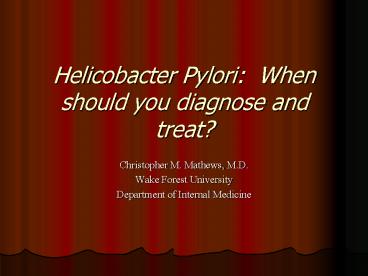Helicobacter Pylori: When should you diagnose and treat - PowerPoint PPT Presentation
1 / 36
Title:
Helicobacter Pylori: When should you diagnose and treat
Description:
Hp (-) with predominat GERD - PPI. Hp (-), NSAID (-), & GERD (-) - reassure. Prompt EGD ... GERD. Eradication of Hp in the last 6 months. IBS. Methods ... – PowerPoint PPT presentation
Number of Views:319
Avg rating:3.0/5.0
Title: Helicobacter Pylori: When should you diagnose and treat
1
Helicobacter Pylori When should you diagnose
and treat?
- Christopher M. Mathews, M.D.
- Wake Forest University
- Department of Internal Medicine
2
Patient 1
- 38 y.o. male No pmhx transported to the CCU after
presenting to Elkin with CP and found to have a
troponin .02. The patient rules out for a mi
overnight. The next a.m. after further
questioning you discover that the patient has had
epigastic pain with excessive belching for the
last three days. Patient denies every
experiencing the pain before. What should you do?
3
Helicobacter pylori
4
Epidemiology
- Over ½ the worlds population infected
- Less than 20 with associated conditions
- High density of living
- Low socioeconomic
- In U.S., more common in Blacks/Hispanics
5
Its all about Urease
- Urea -gt
- Ammonia CO2
- Neutralizes acid
- Forms protective cloud around Hp
6
pH dependent urea channel
- Opened with acidic environment
- Increase the pH with PPI or H2 blocker affects
urease activity - Decrease the urease activity -gt decrease the
sensitivity of urease base test - Off meds for 2 4 weeks
- Can affect UBT, Bx, histology
7
Diagnostic Tests
- Noninvasive
- Invasive
8
Noninvasive Tests
- Serology IgG antibodies to H. pylori, only
indicates infection, does not confirm if active - Urea Breath test on urea 12C replaced by 13C or
14C - Stool antigen
9
Invasive Tests
- Biopsy urease test affected by antisecretory
meds. - Histology -
- Culture sensitivities, reserved for individuals
that have failed 2 or more attempts at
eradication
10
Tests available at the Baptist
- Serology
- Histology
11
Key Point
- Order the test only if you plan to treat a
positive result
12
Guidelines for testing
- Active peptic disease
- Documented h/o peptic ulcer disease
- Mucosal-associated-lymphoid-type lymphoma (MALT)
- ?
13
Lassen et alTest and Treat Compared to Prompt EGD
- Randomized trial
- Patients referred by GP in Denmark to university
hospital - gt two weeks of dyspepsia
14
Exclusion
- lt 18 years of age
- Previous GI surgery
- Tx with ulcer healing meds in the last month
- Pregnant
- Alarm type symptoms
15
Alarm symptoms
- Anorexia
- Anemia
- Weight loss
- Gross/occult GI bleed
- Dysphagia
- Severe/recurrent emesis
16
Methods
- Randomized to test and treat or prompt EGD
biopsy
17
Test and Treat
- Hp () -gt two weeks of erad. Tx
- Hp (-) , NSAID use one month prior to study -gt
EGD - Hp (-) with predominat GERD -gt PPI
- Hp (-), NSAID (-), GERD (-) -gt reassure
18
Prompt EGD
- EGD biopsy -gt treatment based on findings
19
EGD Findings
- 129 (52) Normal
- 70 (28) Reflux esophagitis
- 25 (10) Gastric ulcer
- 22 (9) Duodenal ulcer
- 2 (1) Gastric cancer
20
Gastric Cancer
- 76 y.o. male with Hp (), adenocarcinoma
- 22 y.o. male with Hp (-) malignant lymphoma
21
Survey
- G.I. symptom scale
- Influence of dyspeptic symptoms
- Satisfaction with treatment
- Utilization of medical services ( presciptions,
GP visits, sick days, procedure, etc.)
22
Results
- No statistically significant differences except
for satisfaction with treatment and total numbers
of EGD
23
Results after one year
24
Numbers of EGD in Test and Treat
- 59 of the patients underwent EGD for continued
symptoms
25
Problems
- No age limit
- Referred to university hospital
26
Chiba ColleaguesEradication of Hp vs acid
suppression
- Double blind placebo controlled trial
- Recruitment/intervention in primary care setting
in Canada - Patient had to be gt 18 y.o. and have
uninvestigated dyspepsia for gt 3 months
27
Exclusion Criteria
- Previous gastric surgery
- Upper GI investigation in last 6 mon. or gt 2
times over the last 10 years - Ulcer or esophageal disease
- GERD
- Eradication of Hp in the last 6 months
- IBS
28
Methods
- Qualified patients underwent Helisal rapid blood
test - 446 () test confirmed with 13C breath test
- 152 (33) had a negative breath test
- 294 patients randomized to receive one week of
triple therapy or one week of PPI , placebo
metronidazole, and placebo clarithromyocin
29
ResultsTreatment outcomes
30
ResultEradication vs. Placebo Cost
31
Adverse Outcomes
- 2 deaths
- Metastatic brain cancer with unknown primary
- 69 y.o. male with esophageal cancer, admitted
three months into study
32
Problems
- No age limit
- Exclusion criteria did not include alarm symptoms
- Inconsistent management (patients were d/c to GP
following one week of eradication or placebo
33
ConclusionsTest and Treat
- lt 45 years of age
- No alarm symptoms
- Dyspepsia symptoms gt 3 4 weeks
- If symptoms persist refer for EGD
34
Patient 1
- H2 blocker, lifestyle changes, and follow up
35
Patient 1 with 4 weeks of dyspepsia
- Test for H. pylori
- () then eradicate
- (-) then PPI trial
36
Patient 2 49 yo male with 4 weeks of dyspepsia
- Refer for EGD































